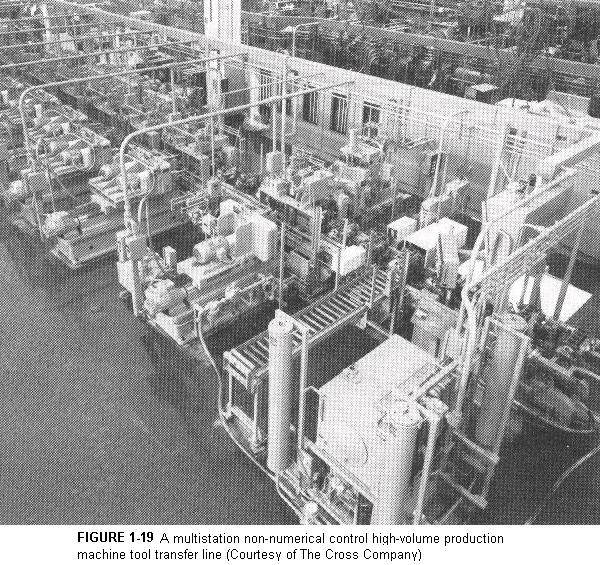
Automated equipment is not always N/C controlled. Automation is the process of controlling manufacturing systems to perform repetitive operations with a minimum of human intervention. Automation may or may not be computerized. Computerization of manufacturing processes enhances flexibility. To change the method of operation one needs only to change the computer program with perhaps minor changes to hardware such as tooling. N/C and manipulative robots are examples of computerized automation equipment.
Flexibility of operation is not needed if the volume of production is high enough to require a machine to be dedicated to producing the same part, running continuously day in and day out. Machines that make such large quantities of the same part are designed exclusively for that specific purpose. The design of such machines need not be compromised for the sake of flexibility. Hence they can be more efficient.
For example, a special-purpose machine may be designed to mill the top of an automobile engine cylinder block casting. Another may bore the cylinder holes, another the camshaft bearing holes, another the crankshaft bearing holes, another drills oil passages, another drills and taps holes for the cylinder head screws, and so on, each machine designed to perform only a single operation.
These machines are grouped together in the factory and connected by a conveyer mechanism to transfer the engine blocks from one machine (or station) to the next. Each machine may have a mechanism to automatically load and unload the workpiece, and automatically measure critical dimensions and shunt defective parts off to the side. Collectively, these machines are called a transfer line (Figure 1.19). They are still the most efficient and cost-effective means to achieve high-volume production such as is found in the automotive and many other industries. They may require little, if any, human intervention, and hence are a form of automation.

Computers are often connected to such transfer-line machines to monitor, coordinate, and control the overall system. But they do not direct the action of the individual machines. That process is built into each individual machine. It is not numerical control.
| What are the Advantages of N/C? |
|---|
Back to Contents Page
Updated Jan. 9, 2002
Copyright © 1988-2002 by George Stanton and
Bill Hemphill
All Rights Reserved